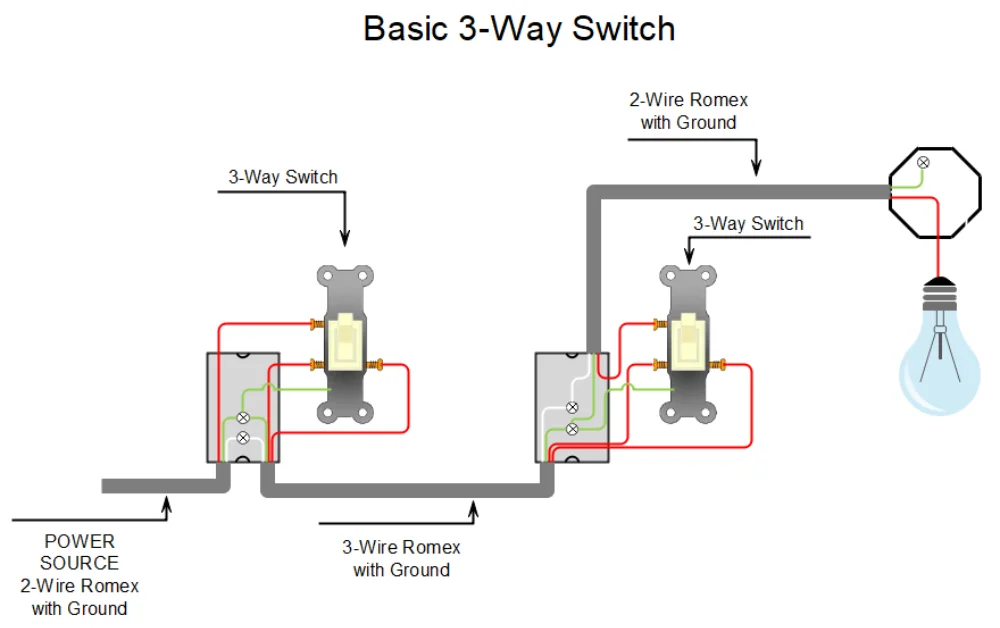How to wire a 3 way light switch
Wiring a 3-way light switch is not as difficult as it might seem at first glance. There are only three wires to connect, after all. However, it helps to have a basic understanding of electrical circuits before attempting this project.
Always remember to turn off the power before working on any electrical project!
- The first step is to identify the two “traveler” wires coming into the box
- (these will be different colors)
- Then, connect one of these traveler wires to each of the terminals on one side of the switch
- (again, they will be different colors)
- The remaining wire will be attached to the common terminal
- (usually labeled with a black dot)
- That’s it! Just make sure that all connections are secure and that no bare wires are touching each other or any metal surfaces inside the box.
What is a 3 way light switch?
A 3-way light switch allows you to control a light from two different locations. For example, you could have a light at the top and bottom of a staircase. A 3-way switch would allow you to turn the light on or off from either location.
How does a 3 way light switch work?
A 3-way switch has three terminals, one more than a regular switch. The extra terminal is called the “common” terminal, and it is usually labeled with a black dot. When the switch is in the “off” position, all three terminals are connected together. When the switch is in the “on” position, the common terminal is connected to one of the other two terminals, depending on which way the switch is flipped.
3-way light switch wiring diagram

A step-by-step guide to wiring a 3-way light switch
In order to wire a 3-way light switch, you will need the following materials: (links to our top choices)
3-way light switch (of your choice)
Step 1: Turn off the power to the circuit that you will be working on. This is done by flipping the breaker switch at your electrical panel.
Step 2: Remove the faceplate from the 3-way light switch using a screwdriver.
Step 3: Cut the wires that are connected to the screws on the side of the faceplate with wire cutters.
Step 4: Strip ½ inch of insulation off of each wire using wire strippers.
Step 5: Connect each wire to a terminal on the new 3-way light switch. The black (hot) wire goes to one of the brass terminals, and the white (neutral) wire goes to one of the silver terminals. The green or bare copper (ground)wire goes to the green terminal.
Step 6: Secure each wire to its respective terminal by tightening down each screw until it is snug against the wire. Be careful not to over tighten as this could damage the wires.
Step 7: Place electrical tape around each terminal in order to insulate them.
Step 8: Put the faceplate back on and screw it into place.
Turn on power at your electrical panel and test your new 3-way light switch!
Common problems with 3-way light switches
One of the most common problems with 3-way light switches is that they stop working. This can be caused by a number of different things, such as a loose wire or a bad connection. Another common problem is that the switch doesn’t turn on or off when it’s supposed to. This can be caused by a variety of factors, including a blown fuse or a tripped circuit breaker.
If your 3-way light switch stops working, the first thing you should do is check the wires to make sure they are all tight and connected properly. If everything looks good there, then the next step is to check the fuse or circuit breaker. If either of these is tripped or blown, then that could be why your light switch isn’t working. If neither of these is the problem, then it’s likely that there is something wrong with the switch itself and you’ll need to replace it.
How to troubleshoot a 3-way light switch?
For a deeper understanding read: How to Fix Light Switch and Outlet Issues
If your 3-way light switch isn’t working, there are a few things you can do to troubleshoot it. First, check the wires to make sure they are all tight and connected properly. Next, check the fuse or circuit breaker. If either of these is tripped or blown, that could be why your light switch isn’t working. Finally, if none of these solutions solve the problem, then it’s likely that there is something wrong with the switch itself and you’ll need to replace it.
FAQs
How to identify a broken light switch?
The first step in knowing how to fix a broken light switch is being able to identify when one exists. There are a few telltale signs that a light switch may be broken, which include:
-The switch does not click when engaged.
-The switch feels loose or wobbly.
–Read more..
What is an arc fault circuit interrupter (AFCI)?
An AFCI is a type of circuit breaker that is designed to protect against electrical fires caused by arcing faults. Read more..
How does an AFCI work?
AFCIs work by sensing when an arc fault is about to occur and then interrupting the flow of electricity before the arc can form. Read more..